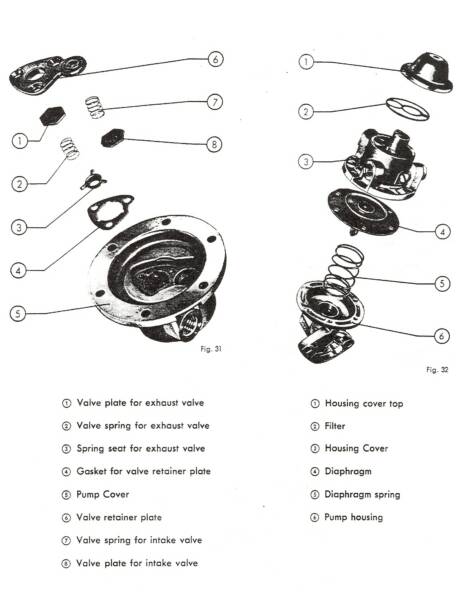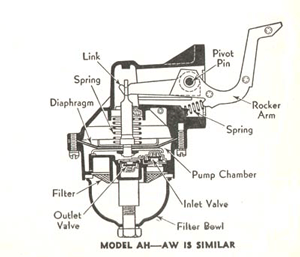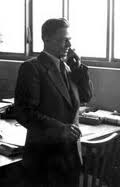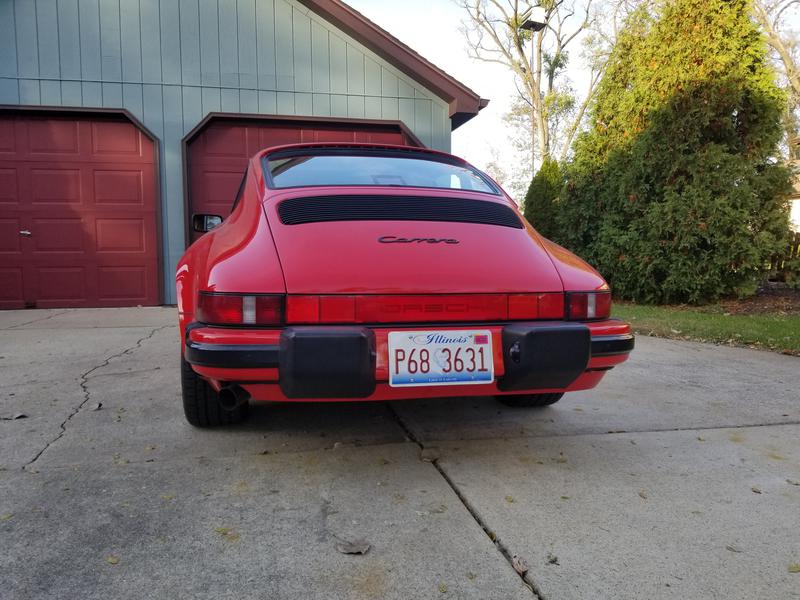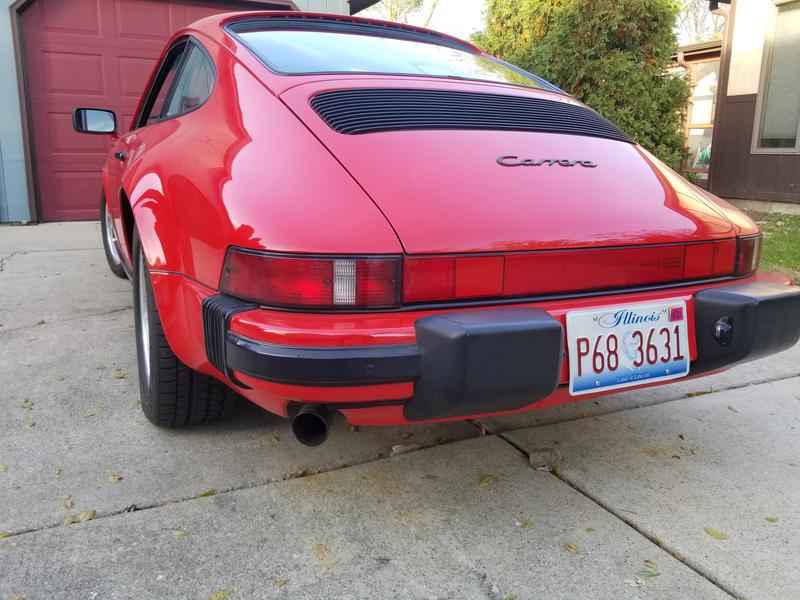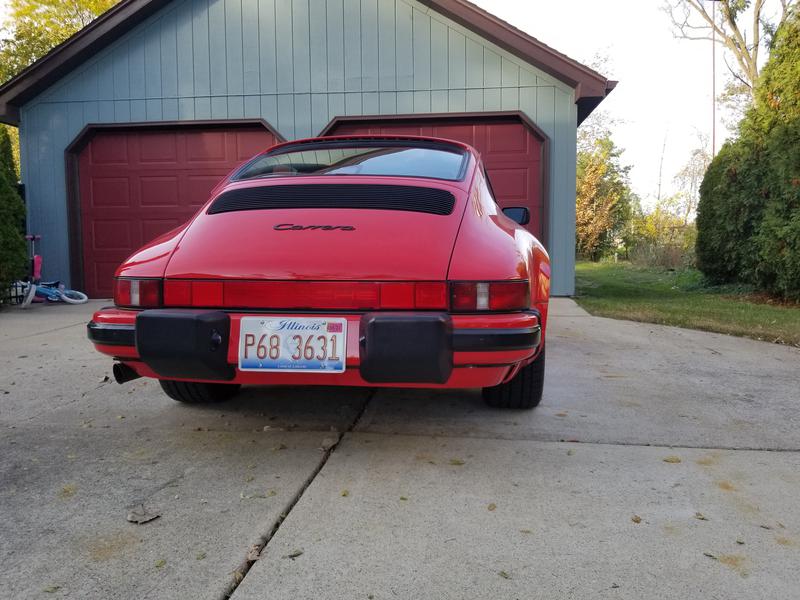
{Type 356 Fuel Pump}
{Porsche 356 fuel pump rebuilding}
DVG (Deutsche Vergaser Gesellschaft)
Porsche 616.08.401 NLA
Pre A ' DVG fuel pump for 1300 - 1500 motors
Fig 1:1 Cross section view
DVG fuel pump for 356 'A and early 'B 1600 motors
' DVG ' (Deutsche Vergasser Gesellschaft) translates to "German Carburetors Society or Group".
A (very) brief history:
The company story is quite confusing but revolves around Alfred Pierburg, his father Bernhard and their steel trading company Pierburg oHG. Around 1926 they acquired licence's from the French Solex company to produce carburetors; failures during the great depression forced Pierburg to reorganize as DVG. Sometime after 1935, DVG, under licence from GM, produced AC fuel pumps for Opel. It was around this time DVG began the development and manufacture of a fuel pump of its own design. After WWII, again with support from friends at French Solex. A new company, Alfred Pierburg g or ' APG ' , (A. Pierburg Auto- und Luftfahrt-Gerätebau KG ) would emerge. During the Porsche 356 era,' DVG 'and ' APG ' were for all economic purposes one company with several manufacturing facilities.
Here are but a few examples of fuel pump wear and abuse!
df 2024
This page was last updated: October 17, 2024
Fig 1:2 Exploded view
DVG fuel pump for 356 'A and early B' 1600 motors
Lower pump housing, shows severe damage from too long of push rod stroke ( too few or no shim gaskets?, missing spacer? ) , forcing rocker arm to hammer the casing to pieces!
Typical worn, suction valve seat, absolutely gone!
It does not matter what new kit you install, or which parts you use. If this seat is worn, the pump is junk!
See, Fig 1:4 below for repair
Worn out suction valve seat showing a culprit.
Valve disc so worn that it's soft face is gone. The exposed phenoelic/fiber disc base is hard enough to wear out the white metal seat!
The Late Pump
Current available Pierburg APG pump
for 356 late 'B / 'C / 912 1600 motors
Porsche part # 616 108 401 00
Other 356 era pumps
The DVG 356 'A/B PUMP
The Early Pump
A Brief History, the early fuel pump
Not unlike AC fuel pumps of the time (see Fig 1:3 (1930's)) the DVG pump transferred mechanical motion perpendicular to the motor. This allowed water and sediment to separate out into the filter bowl. The AC filter bowl was on the bottom and easily drained while the DVG was on top, requiring more time and labor to clean. It's interesting to note DVG produced a pump for Mercedes Benz at this time and provided a water drain port in the filter bowl casting. Also notice, in Fig1:1, the discharge cavity above the delivery valve (discharge valve). During operation there is a cushion of air on top of the fuel column acting to smooth out any hydraulic pulsation of the diaphragm during fuel delivery. This feature was not incorporated in previous or later fuel pump designs 2. This pump ensures a pulse-free delivery of fuel to the carburetors at a constant pressure which helps to reduce needle valve wear and flooding. It also makes the need for a fuel regulator redundant.
This is a self-regulating fuel pump with surge chamber.
Of the 356 era pumps, the A pump is the most robust and forgiving. It has: larger valves & internal porting, largest filter bowl, and its diaphragm is 60% larger in area than the 'C/ 912 pump.
As shown in Fig 1:1, the pump operates as follows: driven by a push rod from a cam on the distributor shaft, with the cam high, the rocker arm thru the rocker arm link pulls down or cocks the diaphragm closing discharge valve allowing fuel to be pulled thru the suction valve. With the cam low, the diaphragm spring pushes the diaphragm up, closing the suction valve and forcing fuel out thru the discharge valve.
The strength of the diaphragm spring determines the outlet pressure, provided the push rod stroke is within range.
The rocker arm and rocker arm link assembly allow for under travel of the diaphragm (the stroke of the push rod does not change, but the travel of the diaphragm does) .
Under normal operating conditions the diaphragm is moved only some .2". As the carburetor float needle valve opens, pressure drops and the working stroke of diaphragm increases. As the needle valve closes, pressure increases and the stroke decreases 3.
It is really quite a piece of engineering. The outlet fuel pressure is sensed and maintained (regulated) by the diaphragm spring thru the diaphragm. This little machine is so well balanced that when rebuilt and installed correctly it has very little movement or wear, yet can deliver copious amounts of fuel at a constant 1.8 to 2.4 P.S.I. !
Was it over engineering or cost of production that led to its successor, which has a fraction of the moving parts and lays on its side?
Fig 1:3 Early AC fuel pump 30's- 40's
1, Harry Pellow the 'Mastero'. I remember Harry from his spirited dialog in the early days of 356 Talk.
2, I have seen Packard AC type fuel pumps from the 1940's with a small surge fitting installed at the pump outlet. Was this accepted engineering practice of the time....? Also, many after-market fuel regulators incorporate anti-surge capability.
3, At no or low flow the discharge valve will hold in place or limit diaphragm movement. This is why good sealing valves are so important for performance and to minimize wear.
Another Lifetime!
Fig 1:4 Upper housing repaired with, new suction valve seat, installed...
See, Rebuilding Page for more information.
Fig 1:6 Rocker arm & link, wear / abuse.
Upper left, arm & link welded together, a sure fix, for busting up lower housing.
Upper right, rocker arms showing wear. Right arm shows more deformation from too much push rod stroke . Left normal.
Lower , link arms broke & repaired ( look at the stress fractures in the tang of repaired link arm ) . Here again, the results of poor installation overstressing parts!
Fig 1:5 More worn parts. Discharge valve seats, valve discs and rocker arm / link pins.
Description of operation
Additional considerations: except under heavy load at wide-open-throttle, an engine needs much less fuel than the fuel delivery system is designed to provide. These diaphragm type fuel pumps have large operating redundancies, therefore it is not uncommon for worn parts that decrease the fuel delivery rate to go for the most part undetected, but will show themselves in poor starting and or performance when large fuel demand is needed.
No affiliation with or approval of Porsche AG or Porsche Cars North America is intended or implied.
Sometimes referred to as the "monkey-motion"1 pump because of all of its moving parts. It is a robust and reliable pump. Also because they were the largest of 356 fuel pumps they delivered an enormous amount of fuel during their lifetime.
Contact Doug, if you are in need of a particular service, price quote or have a question.
email : [email protected]
( Late Fuel Pump)
( Early Fuel Pump )
Repair / Rebuild for the Porsche 356 and 912 Fuel Pump
Includes; 1953 Pre-A to Early 911 Switches
The "Colonel" my 56'A coupe has 'left the building'
My fuel pump bench rebuilds incorporate
American made parts including:
Premium grade nylon inserted nitrile diaphragm fabric suitable for all aromatic fuels
Proprietary;
PTFE (Teflon) valve discs
Stainless steel valve springs
Diaphragm spring
Fuel screen / filter w/ 150 micron rating
Gaskets and red vulcanized fibre compressed washers
Impervious to any fuel chemicals & last a life time with virtually no valve disc or valve seat wear, while delivering fuel at consistent 2.0 to 2.4 PSI...
' 87 Red '
Mezger's Legendary 3.2 with the Getrag G50
